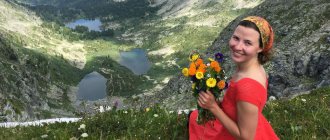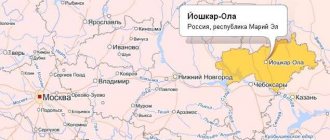Name
The self-name of the Mari people goes back to the word “Mari” or “Mari”, which means “man”. A number of scientists believe that it may be associated with the name of the ancient Russian people Meri, or Merya, who lived on the territory of modern Central Russia and was mentioned in a number of chronicles.
In ancient times, the mountain and meadow tribes that lived in the Volga-Vyatka interfluve were called Cheremis. The first mention of them in 960 is found in a letter from the Khagan of Khazaria Joseph: he mentioned the “Tsaremis” among the peoples who paid tribute to the Khaganate. Russian chronicles noted the Cheremis much later, only in the 13th century, along with the Mordovians, classifying them among the peoples living on the Volga River. The meaning of the name “cheremis” has not been fully established. It is known for certain that the “mis” part, like “mari”, means “person”. However, what kind of person this person was, the opinions of researchers differ. One of the versions refers to the Turkic root “cher”, meaning “to fight, to be at war.” The word “janissary” also comes from him. This version seems plausible, since the Mari language is the most Turkicized of the entire Finno-Ugric group.
Sacred places in Mari El
The Mari, like other ancient peoples, have their own places of worship. There are about 700 Sacred Kyusoto Groves in the republic alone. But besides them, there are other places sacred to many Mari.
Black stones
- Coordinates: village Kozhlaer, Morkinsky district.
Strange stones (or megaliths?) are located in the vicinity of the village of Kozhlaer, Morkinsky district, on the slope of Mount Onis Kuryk. There are 18 of them in total, but no one knows how they appeared here and when. But any local resident can tell you that they are magical.
The stones create a magnetic field around themselves, which is successfully used instead of physiotherapy in the treatment of joint diseases. But it is not recommended to move them from place to place, as disaster may occur.
Poklonnaya Gora
- Address: Podgornaya village.
This is one of the main sacred mountains of the Mari. At its top there is a grove called Kyusoto, in which they worshiped and still worship their ancient gods - the sun, wind, water. They climb the mountain along a steep wooden staircase.
The sacred grove is completely saturated with smoke from the fire and the aroma of sacrificial food. There are items of clothing hung on the trees, because according to the customs of the Mari, if you are bothered by pain, you need to take something off and leave it in the grove with it. And next year make the obligatory sacrifice to the gods.
Sistyvar prayer site
- Address: s. Vilovatovo, Gornomariysky district.
It is located in the very center of the triangle formed by drawing lines between the villages of Vilovatovo, Paratmary and Kizhvachi. 3000 years ago, primitive people called Abashevites lived here. They left behind burial mounds up to one and a half meters high and 15-16 meters in diameter.
Local residents believe that it is in this place that energy exchange takes place between the earth and space. Since ancient times, people came here to pray and brought water to imbue it with energy. It was believed that such water helps against many ailments.
Later, a small chapel was built near the mounds, where many believers came to pray, but in Stalin’s times it was destroyed. In 1995, the church was rebuilt and today this place is still popular. There are especially many believers here on May 22, the day of memory of St. Nicholas the Wonderworker.
Where live
More than 50% of the Mari live in the Republic of Mari El, where they make up 41.8% of its population. The republic is a subject of the Russian Federation and is part of the Volga Federal District. The capital of the region is the city of Yoshkar-Ola. The main area where the people live is the area between the Vetluga and Vyatka rivers. However, depending on the place of settlement, linguistic and cultural characteristics, 4 groups of Mari are distinguished:
- Northwestern. They live outside of Mari El, in the Kirov and Nizhny Novgorod regions. Their language differs significantly from the traditional one, but they did not have their own written language until 2005, when the first book was published in the national language of the northwestern Mari.
- Mountain. In modern times they are small in number - about 30-50 thousand people. They live in the western part of Mari El, mainly on the southern, partly on the northern banks of the Volga. The cultural differences of the mountain Mari began to take shape in the 10th-11th centuries, thanks to close communication with the Chuvash and Russians. They have their own Mountain Mari language and writing.
- Eastern. A significant group consisting of immigrants from the meadow part of the Volga in the Urals and Bashkortostan.
- Meadow. The most significant group in terms of numbers and cultural influence, living in the Volga-Vyatka interfluve in the Republic of Mari El.
The last two groups are often combined into one due to the maximum similarity of linguistic, historical and cultural factors. They form groups of Meadow-Eastern Mari with their own Meadow-Eastern language and writing.
Rivers and lakes of the Mari Republic
The region has a very large number of rivers and lakes, and their total area is about 2.5 thousand hectares. Almost every reservoir has some events and mystical stories associated with it.
Sea Eye Lake
- Coordinates on the map: 56.162632, 48.759988.
A small reservoir a few kilometers from the border with Tatarstan is approximately 20,000 years old. It is considered the most popular in the republic not only because of the water’s unusual emerald hue, but also because of its great depth, which is completely unusual for its modest size. From a bird's eye view, it resembles a pit dug right into the mountainside, which is why the locals call it Mishul (Funnel).
Lake Nuzhyar
- GPS coordinates: 56.585027, 46.359204.
The most transparent lake in the republic is located in the Gornomariysky district. Fishing here is not very good - as reviews say, only perch is found here. But this is an ideal place for swimming.
The sandy bottom is practically without vegetation, and the water transparency reaches 8 meters. The banks of the reservoir do not have cliffs, and the depth increases gradually. In general, here nature has created good conditions for a wild but comfortable holiday.
Lake Tabashinskoye (Zryv)
- Coordinates: 56.981567, 47.805644.
Tabashinskoye is considered both the most mysterious and deepest lake in the region. According to some data, its bottom is located at a depth of 53 m, according to others - 171 m!!! Such an incredible depth is considered impossible for lakes of karst origin, to which it belongs. Scuba divers claim that the middle of the reservoir is a funnel, and real trees grow at the bottom. But instead of animals and birds, voiceless fish live in their crowns.
Lake Yalchik
- Coordinates: 56.008837, 48.426991.
It is considered the largest in the republic and consists of two parts - Big and Small Yalchik, connected by a canal. At certain times of the year it dries up and the lakes become isolated from each other. The water here is always clean, and most importantly, warm, so there are always a lot of vacationers on the shores.
Lake Zhenskoe
- Coordinates: 56.368046, 46.190357.
The reservoir, which has such an unusual name, is located in the Yurinsky district, spread between the Vetluga and Rutka rivers. The lake is suitable for swimming, but that’s not the only reason it attracts attention. It seems incredible, but tourists try to see the gilded monastery dome with a cross in its depths.
According to legend, back in the 20th century, on the site of the reservoir there was a convent, the inhabitants of which took a strict vow not to commit adultery. But when one of them violated it, that same night the monastery went underground, and in its place a wonderful lake formed. Everyone managed to escape except that same harlot.
Mouth of the Ilet River
- Coordinates: 55.931795, 48.242583.
The banks of the right tributary of the Volga are very popular among local residents and tourists. Here everyone can find something to suit their taste. There are organized beaches for a comfortable holiday, muddy beaches for those who want to improve their health, and stormy currents for rafting and kayaking. The sandy bottom, crystal clear water and mixed forest leave the most pleasant impressions and a desire to return here again and again.
Lake Green
- Coordinates: 55.975904, 48.331294.
It is located near the border with Chuvashia and is not yet known to a very wide circle. Only local residents and fishermen come to the shores of this lake to relax and sit with a fishing rod away from the civilized world. A small body of water, surrounded by pine forests and sandy beaches, is considered the main attraction of these places.
Salt Lake
- Coordinates: 56.563259, 47.362667.
This body of water on the left bank of Bolshaya Kokshaga is unique. There are no others like him in the Volga region. The surface layer of its waters contains a high concentration of salts, characteristic of the seas.
The water of the lake is completely opaque and has a dark brown tint. And if you lift a little sludge from the bottom, you can smell the pungent smell of hydrogen sulfide. The lake is considered a natural monument and is located in the Medvedevsky district.
Lake Glukhoe
- Coordinates: 56.038685, 48.455037.
The second name of the lake is Glukharinoe. This is a small, only a few hundred meters in length and width, crescent-shaped reservoir with a depth of about 3-4 meters. It is located on the territory of the Mari Chodra National Park and is popular among residents of the Volzhsky region. The water in it is both cloudy and clear, but always clean.
Lake Shilma
- Coordinates: 56.459328, 48.345748.
The reservoir in the Sovetsky district of Mari El is considered one of the creepiest. According to stories, at its bottom there is a mass burial of prisoners of war who were shot and drowned in the lake.
The corpses of hopeless soldiers who died from illness were also dumped there. Despite these rumors, it is popular among fishermen, because at its bottom there is a pike whose weight reaches 7-8 kg.
Number
The number of Mari, according to the 2010 census, is more than 574 thousand people. Most of them, 290 thousand, live in the Republic of Mari El, which translated means “the land, the homeland of the Mari.” A slightly smaller, but largest community outside of Mari El is located in Bashkiria - 103 thousand people.
The remaining part of the Mari inhabits mainly the Volga and Ural regions, living throughout Russia and beyond. A significant part lives in the Chelyabinsk and Tomsk regions, Khanty-Mansiysk Autonomous Okrug. The largest diasporas:
- Kirov region - 29.5 thousand people.
- Tatarstan - 18.8 thousand people.
- Udmurtia - 8 thousand people.
- Sverdlovsk region - 23.8 thousand people.
- Perm region - 4.1 thousand people.
- Kazakhstan - 4 thousand people.
- Ukraine - 4 thousand people.
- Uzbekistan - 3 thousand people.
Language
The Meadow-Eastern Mari language, which, along with Russian and Mountain Mari, is the state language in the Republic of Mari El, is part of a large group of Finno-Ugric languages. And also, along with the Udmurt, Komi, Sami, and Mordovian languages, it is part of the small Finno-Perm group. There is no exact information about the origin of the language. It is believed that it was formed in the Volga region before the 10th century on the basis of Finno-Ugric and Turkic dialects. It underwent significant changes during the period when the Mari joined the Golden Horde and the Kazan Kaganate. Mari writing arose quite late, only in the second half of the 18th century. Because of this, there is no written evidence about the life, life and culture of the Mari throughout their formation and development. The alphabet was created on the basis of Cyrillic, and the first text in Mari that has survived to this day dates back to 1767. It was created by the Mountain Mari who studied in Kazan, and it was dedicated to the arrival of Empress Catherine the Second. The modern alphabet was created in 1870. Today, a number of national newspapers and magazines are published in the Meadow-Eastern Mari language, and it is studied in schools in Bashkiria and Mari El.
Story
The ancestors of the Mari people began to develop the modern Volga-Vyatka territory at the beginning of the first millennium of the new era. They migrated from the southern and western regions to the East under pressure from aggressive Slavic and Turkic peoples. This led to assimilation and partial discrimination of the Permians who originally lived in this territory.
Some Mari adhere to the version that the ancestors of the people in the distant past came to the Volga from Ancient Iran. Afterwards, assimilation took place with the Finno-Ugric and Slavic tribes living here, but the identity of the people was partially preserved. This is supported by research by philologists, who note that the Mari language has Indo-Iranian inclusions. This is especially true for ancient prayer texts, which have remained virtually unchanged for centuries. By the 7th-8th centuries, the Proto-Marians moved north, occupying the territory between Vetluga and Vyatka, where they live to this day. During this period, the Turkic and Finno-Ugric tribes had a serious influence on the formation of culture and mentality. The next stage in the history of the Cheremis dates back to the X-XIV centuries, when their closest neighbors from the west were the Eastern Slavs, and from the south and east - the Volga Bulgars, Khazars, and then the Tatar-Mongols. For a long time, the Mari people were dependent on the Golden Horde, and then on the Kazan Khanate, to whom they paid tribute in furs and honey. Part of the Mari lands was under the influence of Russian princes and, according to the chronicles of the 12th century, were also subject to tribute. For centuries, the Cheremis had to maneuver between the Kazan Khanate and the Russian authorities, who tried to attract the people, whose number at that time amounted to up to a million people, to their side. In the 15th century, during the period of aggressive attempts by Ivan the Terrible to overthrow Kazan, the mountain Mari came under the rule of the king, and the Meadow Mari supported the Khanate. However, due to the victory of the Russian troops, in 1523 the lands became part of the Russian State. However, the name of the Cheremis tribe does not mean “warlike” for nothing: the very next year it rebelled and overthrew the provisional rulers until 1546. Subsequently, the bloody “Cheremis Wars” broke out twice more in the struggle for national independence, the overthrow of the feudal regime and the elimination of Russian expansion. For the next 400 years, the life of the people proceeded relatively calmly: having achieved the preservation of national authenticity and the opportunity to practice their own religion, the Mari were engaged in the development of agriculture and crafts, without interfering in the socio-political life of the country. After the revolution, the Mari Autonomy was formed, in 1936 - the Mari Autonomous Soviet Socialist Republic, in 1992 it was given the modern name of the Republic of Mari El.
Appearance
The anthropology of the Mari goes back to the ancient Ural community, which formed the distinctive features of the appearance of the peoples of the Finno-Ugric group as a result of mixing with Caucasians. Genetic studies show that the Mari have genes for haplogroups N, N2a, N3a1, which are also found among the Vepsians, Udmurts, Finns, Komi, Chuvash and Baltic people. Autosomal studies showed kinship with the Kazan Tatars.
The anthropological type of modern Mari is Suburalian. The Ural race is intermediate between Mongoloid and Caucasian. The Mari, on the other hand, have more Mongoloid characteristics compared to the traditional form. Distinctive features of appearance are:
- average height;
- yellowish or darker skin color than Caucasians;
- almond-shaped, slightly slanted eyes with downward outer corners;
- straight, dense hair of a dark or light brown shade;
- prominent cheekbones.
Cloth
Men's and women's traditional costumes were similar in configuration, but women's were decorated more brightly and richly. Thus, everyday attire consisted of a tunic-like shirt, which was long for women and did not reach the knees for men. They wore loose pants underneath and a caftan on top.
Underwear was made from homespun fabric, which was made from hemp fibers or woolen threads. The women's costume was complemented by an embroidered apron; the sleeves, cuffs and collars of the shirt were decorated with ornaments. Traditional patterns - horses, solar signs, plants and flowers, birds, ram's horns. In the cold season, frock coats, sheepskin coats and sheepskin coats were worn over it. A mandatory element of the costume is a belt or waist wrap made of a piece of linen material. Women complemented it with pendants made of coins, beads, shells, and chains. Shoes were made of bast or leather; in swampy areas they were equipped with special wooden platforms. Men wore tall hats with narrow brims and mosquito nets, since they spent most of their time outside the home: in the field, in the forest or on the river. Women's hats were famous for their great variety. The magpie was borrowed from the Russians, and the sharpan, that is, a towel tied around the head and fastened with an ochel - a narrow strip of fabric embroidered with traditional ornaments, was popular. A distinctive element of the bride’s wedding costume is a voluminous chest decoration made of coins and metal decorative elements. It was considered a family heirloom and was passed down from generation to generation. The weight of such jewelry could reach up to 35 kilograms. Depending on the place of residence, the features of costumes, ornaments and colors could vary significantly.
Family life
After the wedding, the bride went to live in her husband’s house, so the Maries had large families. Families of brothers often coexisted in them; older and subsequent generations, the number of which reached 3-4, lived together. The head of the household was the eldest woman, the wife of the head of the family. She gave children, grandchildren and daughters-in-law tasks around the house and looked after their material well-being. Children in the family were considered the highest happiness, a manifestation of the blessing of the Great God, so they gave birth a lot and often. Mothers and the older generation were involved in upbringing: children were not spoiled and were taught to work from childhood, but they were never offended. Divorce was considered a shame, and permission for it had to be asked from the chief minister of the faith. Couples who expressed such a desire were tied back to back in the main village square while they awaited a decision. If a divorce occurred at the request of a woman, her hair was cut off as a sign that she was no longer married.
Festival of satire and humor Benderiad in Kozmodemyansk
There is a lot of entertainment for children on the Market Square of Kozmodemyansk:
A large, elegant Children's Town for the delight of children:
Ostap Bender's performance in the festive humor:
The festival continues on the banks of the Volga - yachts and parachutists take part in the celebration:
I suggest you watch a cool movie:
Life
The main occupation of the Mari people was arable farming. Field crops - spelled, oats, flax, hemp, buckwheat, oats, barley, rye, turnips. Carrots, hops, cabbage, potatoes, radishes, and onions were planted in the gardens. Animal husbandry was less common, but poultry, horses, cows and sheep were bred for personal use. But goats and pigs were considered unclean animals. Among men's crafts, wood carving and silver processing to make jewelry stood out. Since ancient times they have been engaged in beekeeping, and later in apiary beekeeping. Honey was used in cooking, intoxicating drinks were made from it, and was also actively exported to neighboring regions. Beekeeping is still common today, providing a good source of income for villagers.
Culture
Due to the lack of writing, Mari culture is concentrated in oral folk art: fairy tales, songs and legends, which are taught to children by the older generation from childhood. An authentic musical instrument is the shuvyr, an analogue of the bagpipe. It was made from a soaked cow's bladder, supplemented with a ram's horn and a pipe. He imitated natural sounds and accompanied songs and dances along with the drum.
There was also a special dance for cleansing from evil spirits. Trios, consisting of two guys and a girl, took part in it; sometimes all residents of the settlement took part in the festivities. One of its characteristic elements is the tyvyrdyk, or drobushka: a quick synchronized movement of the legs in one place.
Religion
Religion has played a special role in the life of the Mari people in all centuries. The traditional Mari religion has still been preserved and is officially registered. It is professed by about 6% of the Mari, but many people observe the rituals. The people have always been tolerant of other religions, which is why even now the national religion coexists with Orthodoxy. The traditional Mari religion proclaims faith in the forces of nature, in the unity of all people and everything on earth. Here they believe in a single cosmic god, Osh Kugu-Yumo, or the Great White God. According to legend, he instructed the evil spirit Yin to remove from the World Ocean a piece of clay from which Kugu-Yumo made the earth. Yin threw his part of the clay onto the ground: this is how the mountains turned out. Kugu-Yumo created man from the same material, and brought his soul to him from heaven.
In total, there are about 140 gods and spirits in the pantheon, but only a few are especially revered:
- Ilysh-Shochyn-Ava - analogue of the Mother of God, goddess of birth
- Mer Yumo - manages all worldly affairs
- Mlande Ava - goddess of the earth
- Purysho - god of fate
- Azyren - death itself
Mass ritual prayers take place several times a year in sacred groves: there are between 300 and 400 of them throughout the country. At the same time, services to one or several gods can take place in the grove, sacrifices are made to each of them in the form of food, money, and animal parts. The altar is made in the form of a flooring of fir branches, installed near the sacred tree.
Those who come to the grove prepare the food they brought with them in large cauldrons: meat of geese and ducks, as well as special pies made from the blood of birds and cereals. Afterwards, under the guidance of a card - an analogue of a shaman or priest, a prayer begins, which lasts up to an hour. The ritual ends with eating what has been prepared and cleaning the grove.
Stamps in philately
For the first time, the word “philately” (from the Greek “philio” - love and “ately” - exemption from payment) and “philatelist” were published in the French magazine “Stamp Collector” in 1864.
There are two main directions in philately: traditional (classical) and thematic. Traditional philately is the collecting and systematization of postage stamps from one or more countries, in chronological order, according to catalogs. In our country, most adherents of traditional philately collect the chronology of uncanceled stamps of Russia. Cancelled stamps are less commonly collected. The objects of thematic philately, in contrast to traditional ones, are stamps from different countries on a chosen topic: flora, fauna, art, transport, space, sports, science and technology, etc.
Traditions
The ancient traditions are most fully preserved in wedding and funeral rites. The wedding always began with a noisy ransom, after which the newlyweds, on a cart or sleigh covered with bear skin, headed to the cart for the wedding ceremony. All the way, the groom cracked a special whip, driving away evil spirits from his future wife: this whip then remained in the family for life. In addition, their hands were tied with a towel, which symbolized the connection for the rest of their lives. The tradition of baking pancakes for the newly-made husband on the morning after the wedding has also been preserved.
Funeral rites are of particular interest. At any time of the year, the deceased was taken to the churchyard on a sleigh, and put into the house in winter clothes, supplied with a set of things. Among them:
- a linen towel along which he will descend to the kingdom of the dead - this is where the expression “good riddance” comes from;
- rosehip branches to ward off dogs and snakes guarding the afterlife;
- nails accumulated during life in order to cling to rocks and mountains along the way;
Forty days later, an equally terrible custom was performed: a friend of the deceased dressed in his clothes and sat down with the relatives of the deceased at the same table. They took him for dead and asked him questions about life in the next world, conveyed greetings, and told him news. During the general holidays of remembrance, the deceased were also remembered: a separate table was set for them, on which the hostess put little by little all the treats that she had prepared for the living.
Issue of stamps today
JSC "Marka" publishes postage stamps of the Russian Federation, providing them to all post offices and philatelic salons "Collector". In 1857, the Postal Department of the Russian Empire established the Stamp Expedition, which was responsible for issuing the first stamps of the Russian Empire. It is from this moment that the current joint stock company “Marka” traces its history. Today, Marka JSC, in partnership with Goznak JSC, issues an average of one hundred and fifty postage stamps with various subjects annually.
Since 2001, Marka JSC has repeatedly published truly unique postal miniatures. Among them are postage stamps with foil stamping from 22 and 24 carat gold and silver, postage stamps with hidden text, aromatic coating, imitation of various coatings, augmented reality. One of the important activities of Marka JSC is the organization of joint postal issues with different countries. Postal miniatures created by Marka JSC take prizes at world and international competitions, as well as major philatelic exhibitions and forums.
Famous Mari
One of the most famous Mari is actor Oleg Taktarov, who played in the films “Viy” and “Predators”. He is also known throughout the world as the “Russian Bear,” the winner of brutal UFC fights, although in fact his roots go back to the ancient Mari people.
The living embodiment of a real Mari beauty is the “Black Angel” Varda, whose mother was a Mari by nationality. She is known as a singer, dancer, model and curvy figure.
The special charm of the Mari lies in their gentle character and mentality based on the acceptance of all things. Tolerance towards others, coupled with the ability to defend their own rights, allowed them to maintain their authenticity and national flavor.
Artistic postage stamps
Artistic postage stamps (commemorative) are issued for memorable dates and reflect the cultural and historical heritage, the main events of domestic and international life, the achievements of mankind in all fields of knowledge, the rich flora and fauna of our country. The circulation of art stamps is limited and additional printing is not done.
Due to their diversity and artistic value, commemorative postage stamps are becoming the main collection material for philatelists - postage stamp collectors.






